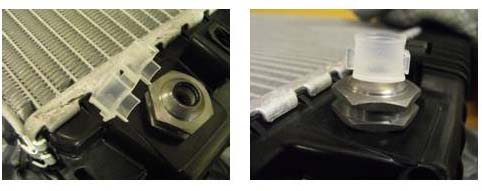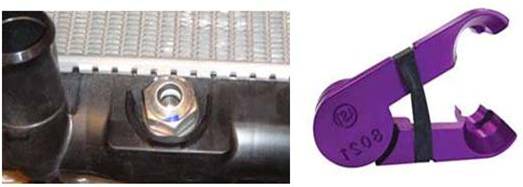| In our last tech tip article we reviewed the Jiffy-Tite® connector design which General Motors engineers started to use in some applications in 1996. While most GM vehicles use Jiffy-Tite® connectors today, the exception is on some of the Cadillac platforms. The 2003 Cadillac CTS introduced a new low profile quick connect which has proved troublesome to many technicians who see it for the first time. The new quick connect design used on several Cadillac models is similar to that also used on 2003 Ford Explorer and F-150 models. See photos below for details of the new connector design as applied on some Ford applications.
Ford Oil Cooler Quick connect and Dis-connect tool
Cadillac CTS Oil Cooler Quick Connect and Disconnect Tool As discussed in the last Tech Tip, the Cadillac application uses an integrated quick connect design to not only make the connection between the oil cooler and the line but also to secure the oil cooler in the radiator tank. These fittings are not intended to be disturbed once the radiator leaves the factory. Cadillac CTS Oil Cooler Quick Connect and Fitting Removed
Loosening the integrated fittings compromises the factory seal between the oil cooler and the radiator tank and the joint cannot be reliably repaired. If a technician removes the oil cooler fitting from a new radiator in most all cases the radiator must be scrapped.
|
-
Join 220 other subscribers
-
Categories
-
Archives



Comments
my mechanic disabled the oil coolant in my 2003 cts saying its not necessary is that correct
In tank oil coolers serve two functions. The primary function is to limit the temperature of the transmission fluid so that it does not overheat and oxidize. If the oil gets too hot it will be permanently damaged and will not provide adequate lubrication for the transmission. The secondary function of an intank cooler is to transfer heat into the transmission oil and transmission to improve driveability at start up in cold climates. It functions first as a heater and then as a cooler.
You should not disable the original oil cooler unless you have another means to assure that the transmission oil temperature is maintained within limits. The best solution for your application is to return it to OE like condition. Repairing a transmission is going to cost you more than fixing the cooling system.
This helps alot – Thanks for posting. I’m in the process of replacing my radiator due to the pass. side fitting disconnecting from the radiator on my way home from work. Whats the best way to refill the transmission on a CTS?
and whats the Part Number for the purple disconnect tool shown above?
Assenmacher Specialty Tools 8021 Domestic Vehicles Oil Cooler Line Remover
Part # AST8021
Sorry…but I do not know the specific refill procedure for the CTS.
my oem radiator did not have the quick connection but I bought a new one and it did and now I cannot get the transmission lines in the cooler, do I need new lines?
What vehicle are you repairing? The only time I have seen the problem that you describe is on the 2003 Saturn Ion. For some reason these vehicles did not use a quick connect fitting. The solution is to choose a different brand radiator that is designed to use the Jiffy-Tite fitting which have a conventional inverted flare design on the radiator side of the fitting.
need to know how to purchase the said item & from where
hi. what is the procedure if the coupling is leaking? is a full radiator and transmission line replacements necessary or can just the coupling be replaced? i don’t have any oil mixing with antifreeze. you can “wiggle” the transmission line (line is towards the center of the radiator). just a little bit is leaking. I have an appointment with a dealer to get it fixed. I would prefer to do whatever replacements myself. Thanks
Some couplings are serviceable and others are not. Generally the couplings that not only mate with the transmission lines but also secure the oil cooler in the radiator tank cannot be serviced. Most OE Ford Radiators have couplings that cannot be serviced but many of the GM OE radiators do have serviceable couplings.
Trackbacks
[…] over which I'd rather not do. Here's some info on the "Jiffy-Tite" fittings on the later trucks: Oil Cooler Connections ? Ford Truck & Cadillac CTS | Iceman Cooling Journal "I have a great pain between my ears" – one of the human beings in the movie Little Big Man said […]